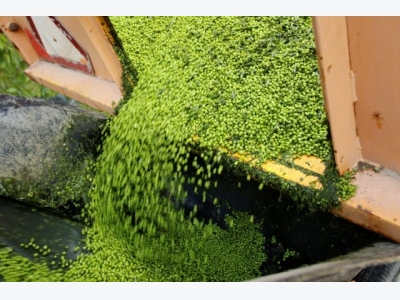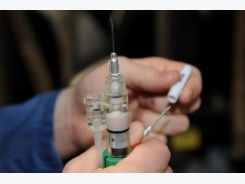Field peas as a protein source for dairy cows

What is the effect of a partial substitution of soybean meal and corn grain with field peas in dairy cow diets? Researchers did some studies on this topic and conclude that replacement is possible, but adding extra amino acids might be advisable.
Total European Union protein crop production currently occupies only 3% of the Union’s arable land and supplies only 30% of the protein crops consumed as animal feed in the EU. Almost 70% of the EU’s protein rich feeds are imported, and for soybean meal this figure is over 97%. The Focus Group on Protein Crops of the European Innovation Partnership, which addressed the challenge of improving the profitability of protein crops in Europe, suggested alternatives to soybean meal should meet three requirements in order to be or become an option for the animal feed industry. Firstly, the protein content should be high. Secondly, the protein quality should be high: good digestibility of amino acids and amino acid profile. And lastly, the price level should be low.
Due to their high protein content, the EU has promoted the production of field peas (Pisum sativum). Data reported by Eurostat (2012) showed field peas were planted in 520,000 ha, field and broad beans in 460,000 ha, and lupins in 84,000 ha. One the advantages of reducing the protein deficit in the EU is in the context of climate change. The European Parliament (2011) states that “the production of protein crops can help to reduce greenhouse gas emissions through the assimilation and fixation of nitrogen in the soil (amounting to up to 100 kg nitrogen/ha per month) and the consequent reduction in the use of synthetic nitrogen fertiliser, which contains nitrous oxide, with warming potential being 310 times higher than that of carbon dioxide”.
Nutritional composition
According to the results from 3,932 samples published by the INRA (2004), the composition and nutritional value of peas (in dry matter basis; DM) is:
• Protein: 24% crude protein with 86% of it degradable in the rumen.
• Carbohydrates non-fibrous: 52% starch (79% being ruminally degraded) and 5% sugars
• Carbohydrates fibrous:14% and 5% neutral and acid detergent fibre, respectively
• Fat: 1% ether extract
• Amino acids: high lysine concentration (7.3% CP) and low methionine (1.0% CP).
• Minerals: 1.1% potassium, 0.5% phosphorus, and 0.25% sulfur
Replacement of soybean meal
Researchers from the Department of Animal and Veterinary Science, University of Idaho investigated the effect of a partial substitution of soybean meal and corn grain with field peas in dairy cow diets. Approximately 45% of the corn grain and 78% of the soybean meal in the control diet were replaced with 15% (DM basis) field peas in the experimental diet. The peas used in the trial contained 25% crude protein and an estimated 1.98 megacalories of net energy for lactation/kg. Dry matter intake (26.1 kg/d), milk yield (35.5 kg/d), 4% fat-corrected milk yield (33.8 kg/d), milk fat and protein content (3.65% and 3.0%, respectively), and milk nitrogen efficiency (25%) were not affected by diet. Similarly, in a study conducted in the Facoltà di Agraria, Università Cattolica del Sacro Cuore, Italy, peas (2.5 kg/cow/day) partially replaced soybean meal (55%) and completely replaced barley meal in diets for lactating cows. On a dry matter basis, diets were composed by corn silage (31.2%), alfalfa hay (16.7%), grass hay (4.1%), and concentrates. The authors reported no negative effects on intake, milk yield, and milk composition. In addition, no differences were observed among feeding groups on ammonia and volatile fatty acids (acetate, propionate, and butyrate) concentrations in rumen fluid collected three hours after morning meal.

Replacing corn and soybean meal with field peas decrease linearly performance of high producing cows. Photo: Ronald Hissink Replacing corn and soybean meal with field peas decrease linearly performance of high producing cows. Photo: Ronald Hissink
No effect on milk yield
Workers from the Department of Agricultural, Food and Nutritional Science, University of Alberta, Canada, determined the nutritive value for late-lactating dairy cows of peas relative to soybean meal and barley. Peas replaced soybean meal at the levels of 0, 33.3, 66.7%, and 100% of the concentrate portion in the diets and were included in the diets at a rate of 0, 10, 20, and 30% of DM. In the 100% pea-based diet, barley was replaced (at 72.35%) to obtain a similar starch content as the soybean meal-based concentrate. Diets included 50% forage (DM basis), and the forage components of the diets consisted of 25% alfalfa silage and 25% brome grass silage. Dry matter intake (21.6 kg/d), milk yield (21.5 kg/d), and milk composition were not affected by substitution of peas for soybean meal and barley. The absence of treatment differences in milk yield could reflect the fact that protein quality is not important in low production cows.
Different for high producing cows
However, results were different in high production cows. South Dakota State University scientists found that replacing corn and soybean meal with field peas, decreases linear performance of high producing cows. These authors formulated diets to replace corn and soybean meal with field peas at 0,12, 24, and 36% (DM basis) of the diet. With increasing inclusion rate of field peas in the diet, intake, milk yield, milk components decreased linearly. These results show that replacing corn and soybean meal with field peas at 24% of the diet or greater negatively affects the percentage and yield of milk protein. The amino acidic profile in peas shows a high lysine content but a relative deficiency in sulphur amino acids compared to soybean meal. The methionine content is 2.15% of essential amino acids (EAA) for peas and 3.19% of EAA for soybean meal (NRC, 2001). A deficiency of methionine could possibly occur when peas are fed at high inclusion level to high producing dairy cows.
Conclusion
Field peas can successfully replace soybean meal in dairy cow diets. However, provision of supplemental rumen-protected methionine may be necessary when peas are fed to high producing dairy cows.
Có thể bạn quan tâm
Phần mềm

Phối trộn thức ăn chăn nuôi

Pha dung dịch thủy canh

Định mức cho tôm ăn

Phối trộn phân bón NPK

Xác định tỷ lệ tôm sống

Chuyển đổi đơn vị phân bón

Xác định công suất sục khí

Chuyển đổi đơn vị tôm

Tính diện tích nhà kính

Tính thể tích ao hồ



 A holistic approach to reducing TBC
A holistic approach to reducing TBC  Health: First things first
Health: First things first